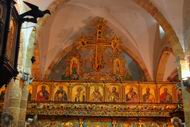This Greek Catholic Church, built in 1765, is located on the southern-western side of the old city of Acre, over the ruins of a Crusader church.
Home > Sites > Acre > St. Andrews Greek Catholic Church
Contents:
Background
Melkite
Location
History
Photos
* Exterior
* Entrance
* Interior
* Altar
* Services
* Bell Tower
* Courtyard
Links
Background:
This Greek Catholic (Melkite) Church, built in 1765, is located on the southern-western side of the old city of Acre. It is named after St. Andrews, one of the twelve apostles of Jesus. The church was built on the remains of a Crusader church.
Melkite Catholic Church:
The Greek Catholic Church, also known as the Melkite Catholic Church, is an Eastern Catholic Church in full communion with the Roman Catholic Church. The term “Melkite” comes from the Arabic word “malka,” which means “king” or “royal,” and refers to the church’s historic connections with the Byzantine Empire and the Eastern Roman (Byzantine) Emperor.
The Melkite Catholic Church traces its roots back to the early Christian communities of Antioch, Syria, which was an important center of Christianity in the early centuries of the Church. The church was originally known as the “Church of Antioch,” and its liturgy and traditions were heavily influenced by the Greek-speaking Christians of the Byzantine Empire.
In the 5th century, a split occurred between the Church of Antioch and the rest of the Eastern Orthodox Church over theological differences related to the nature of Christ. The Melkite Church emerged as a distinct entity within the Eastern Christian world, with its own patriarch and hierarchy.
In the 18th century, some Melkite Catholics entered into communion with the Roman Catholic Church, and the Melkite Catholic Church was formally recognized as a sui iuris (“self-governing”) Eastern Catholic Church by the Vatican in the 19th century. Today, the Melkite Catholic Church has its headquarters in Damascus, Syria, and is led by a patriarch who is recognized as a cardinal of the Roman Catholic Church.
The liturgy of the Melkite Catholic Church is based on the Byzantine Rite, which is also used by other Eastern Catholic and Orthodox churches. The church also has its own particular customs and traditions, including the use of Arabic in the liturgy and the celebration of the Divine Liturgy according to the “Rite of Jerusalem.”
The Melkite Catholic Church has a strong presence in the Middle East, particularly in Syria, Lebanon, and Jordan, as well as in other parts of the world, including the United States, Canada, and Australia. The church is known for its commitment to interfaith dialogue and its efforts to promote peace and justice in the region.
